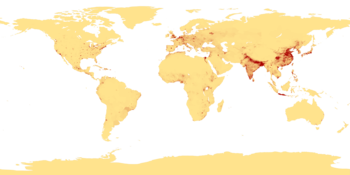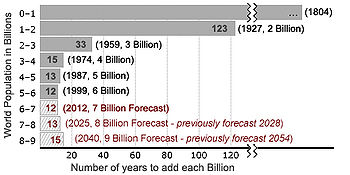Population
From Wikipedia, the free encyclopedia


In biology, a population is the collection of inter-breeding organisms of a particular species; in sociology, a collection of human beings. Individuals within a population share a factor may be reduced by statistical means, but such a generalization may be too vague to imply anything. Demography is used extensively in marketing, which relates to economic units, such as retailers, to potential customers. For example, a coffee shop that wants to sell to a younger audience looks at the demographics of an area to be able to appeal to this younger audience.
Contents |
[edit] World population
According to papers published by the United States Census Bureau, the world population hit 6.5 billion (6,500,000,000) on February 25, 2006. The United Nations Population Fund designated October 12, 1999 as the approximate day on which world population reached 6 billion. This was about 12 years after world population reached 5 billion in 1987, and 6 years after world population reached 5.5 billion in 1993. However, the population of some countries, such as Nigeria, is not even known to the nearest million[1], so there is a considerable margin of error in such estimates.[2] Population growth increased significantly as the Industrial Revolution gathered pace from 1700 onwards[3]. The last 50 years have seen a yet more rapid increase in the rate of population growth[3] due to medical advances and substantial increases in agricultural productivity, particularly in the period 1960 to 1995[4] made by the Green Revolution.[5] In 2007 the United Nations Population Division projected that the world's population will likely surpass 10 billion in 2055.[6] In the future, world population has been expected to reach a peak of growth, from there it will decline due to economic reasons, health concerns, land exhaustion and environmental hazards. There is around an 85% chance that the world's population will stop growing before the end of the century. There is a 60% probability that the world's population will not exceed 10 billion people before 2100, and around a 15% probability that the world's population at the end of the century will be lower than it is today. For different regions, the date and size of the peak population will vary considerably.[7]
[edit] Population control
Population control is the practice of curtailing population increase, usually by reducing the birth rate. Surviving records from Ancient Greece document the first known examples of population control. These include the colonization movement, which saw Greek outposts being built across the Mediterranean and Black Sea basins to accommodate the excess population of individual states. Infanticide, including abortion, was encouraged in some Greek city states in order to keep population down.[8]
An important example of mandated population control is People's Republic of China's one-child policy, in which having more than one child is made extremely unattractive. This has led to allegations that practices like forced abortions, forced sterilization, and infanticide are used as a result of the policy. The country's sex ratio at birth of 114 boys to 100 girls may be evidence that the latter is often sex-selective. However, other countries without a one-child policy also have similar sex ratios but for different reasons such as nutrition[citation needed].
It is helpful to distinguish between fertility control as individual decision-making and population control as a governmental or state-level policy of regulating population growth. Fertility control may occur when individuals or couples or families take steps to decrease or to regulate the timing of their own child-bearing. In Ansley Coale's oft-cited formulation, three preconditions for a sustained decline in fertility are: (1) acceptance of calculated choice (as opposed to fate or chance or divine will) as a valid element in fertility, (2) perceived advantages from reduced fertility, and (3) knowledge and mastery of effective techniques of control.[9] In contrast to a society with natural fertility, a society that desires to limit fertility and has the means to do so may use those means to delay childbearing, space childbearing, or stop childbearing. Delaying sexual intercourse (or marriage), or the adoption of natural or artificial means of contraception are most often an individual or family decision, not a matter of a state policy or societal-wide sanctions. On the other hand, individuals who assume some sense of control over their own fertility can also accelerate the frequency or success of child-bearing through planning.
At the societal level, declining fertility is almost an inevitable result of growing secular education of women. However, the exercise of moderate to high levels of fertility control does not necessarily imply low fertility rates. Even among societies that exercise substantial fertility control, societies with an equal ability to exercise fertility control (to determine how many children to have and when to bear them) may display widely different levels of fertility (numbers of children borne) associated with individual and cultural preferences for the number of children or size of families.[10]
In contrast to fertility control, which is mainly an individual-level decision, governments may attempt to exercise population control by increasing access to means of contraception or by other population policies and programs.[11] The idea of "population control" as a governmental or societal-level regulation of population growth does not require "fertility control" in the sense that it has been defined above, since a state can affect the growth of a society's population even if that society practices little fertility control. It's also important to embrace policies favoring population increase as an aspect of population control, and not to assume that states want to control population only by limiting its growth. To stimulate population growth, governments may support not only immigration but also pronatalist policies such as tax benefits, financial awards, paid work leaves, and childcare to encourage the bearing of additional children.[12] Such policies have been pursued in recent years in France and Sweden, for example. With the same goal of increasing population growth, on occasion governments have sought to limit the use of abortion or modern means of birth control. An example was Romania's 1966 ban on access to contraception and abortion on demand.
In ecology, population control is on occasions considered to be done solely by predators, diseases, parasites, and environmental factors. In a constant environment, population control is regulated by the availability of food, water, and safety. The maximum number of a species or individuals that can be supported in a certain area is called the carrying capacity. At many times human effects on animal and plant populations are also considered.[13] Migrations of animals may be seen as a natural way of population control, for the food on land is more abundant on some seasons. The area of the migrations' start is left to reproduce the food supply for large mass of animals next time around. See also immigration.
India is another example where the government has taken measures to reduce the country’s population. Concerns that the rapidly growing population would adversely affect economic growth and living standards caused India to implement an official family planning program in the late 1950s and early 1960s; it was the first country in the world to do so.
[edit] Notes
- ^ "Cities in Nigeria: 2005 Population Estimates — MongaBay.com". http://www.mongabay.com/igapo/2005_world_city_populations/Nigeria.html. Retrieved on 2008-07-01.
- ^ "Country Profile: Nigeria". http://news.bbc.co.uk/2/hi/africa/country_profiles/1064557.stm. Retrieved on 2008-07-01.
- ^ a b As graphically illustrated by population since 10,000BC and population since 1000AD
- ^ BBC News | The end of India's green revolution?
- ^ Food First/Institute for Food and Development Policy
- ^ United Nations Population Division (March 13, 2007). World population will increase by 2.5 billion by 2050; people over 60 to increase by more than 1 billion. Press release. http://www.un.org/News/Press/docs/2007/pop952.doc.htm. Retrieved on 2007-03-14. "The world population continues its path towards population ageing and is on track to surpass 9 billion persons by 2050."
- ^ "The End of World Population Growth". http://www.nature.com/nature/journal/v412/n6846/full/412543a0.html. Retrieved on 2008-11-04.
- ^
 "Theories of Population". Catholic Encyclopedia. New York: Robert Appleton Company. 1913. http://en.wikisource.org/wiki/Catholic_Encyclopedia_(1913)/Theories_of_Population.
"Theories of Population". Catholic Encyclopedia. New York: Robert Appleton Company. 1913. http://en.wikisource.org/wiki/Catholic_Encyclopedia_(1913)/Theories_of_Population. - ^ Ansley J. Coale, "The Demographic Transition," Proceedings of the International Population Conference, Liège, 1973, Volume 1, pp. 53-72.
- ^ For illustrations of the distinction between fertility control and fertility levels, see Barbara A. Anderson and Brian D. Silver, "A Simple Measure of Fertility Control," Demography 29, No. 3 (1992): 343-356, and B. A. Anderson and B. D. Silver, "Ethnic Differences in Fertility and Sex Ratios at Birth: Evidence from Xinjiang," Population Studies 49 (1995): 211-226. The fundamental work on models of fertility control was that by Coale and his colleagues. See, e.g., Ansley J. Coale and James T. Trussell, “Model Fertility Schedules: Variations in the Age Structure of Childbearing in Human Populations.” Population Index 40 (1974): 185 – 258.
- ^ For a discussion of the range of "population policy" options available to governments, see Paul Demeny, "Population Policy: A Concise Summary," Population Council, Policy Research Division, Working Paper No. 173 (2003)[1].
- ^ Charlotte Höhn, "Population policies in advanced societies: Pronatalist and migration strategies," European Journal of Population/Revue européenne de Démographie 3, Nos. 3-4 (July, 1988): 459-481.
- ^ See http://en.wikipedia.org/wiki/Hunting#Wildlife_management.
[edit] See also
- Zero population growth
- World population
- 1907 populations
- Biological dispersal
- Biological exponential growth
- Crude birth rate
- Crude death rate
- Demographic economics
- Demography
- Dependency ratios
- Life expectancy
- List of countries by fertility rate
- List of countries by population
- List of countries by population density
- List of religious populations
- Median age
- Migration rate
- Mortality under age 5
- Net migration
- Net reproduction rate
- Nurgaliev's law
- Overpopulation
- Population change
- Population density
- Population ecology
- Population growth rate
- Rate of natural increase
- Rural population
- Sex ratio
- Total fertility
- Urban population
- World's largest cities
[edit] External links
- UNFPA, The United Nations Population Fund
- United Nations Population Division
- CICRED homepage a platform for interaction between research centres and international organizations, such as the United Nations Population Division, UNFPA, WHO and FAO.
- Current World Population
- NECSP HomePage
- Overpopulation
- Population and Health InfoShare. Retrieved February 13, 2005.
- Population in the news homepage
- Optimum Population Trust
- Population Reference Bureau (2005). Retrieved February 13, 2005.
- Population World: Population of World. Retrieved February 13, 2004.
- PopulationData.net - Information and maps about populations around the world. Retrieved March 4, 2005. PopulationData.net (2005).
- SIEDS, Italian Society of Economics Demography and Statistics
- Underpopulation? MercatorNet
- United Nations (2004). Population Division, Department of Economic and Social Affairs. Retrieved February 13, 2004.
- United Nations Economic Commission for Europe - Official Web Site
- United States Census Bureau (2005). Census Bureau - Countries Ranked by Population. Retrieved February 13, 2005.
- World Population Counter, and separate regions.
- WorldPopClock.com. (French)
- Populations du monde. (French)
- OECD population data

